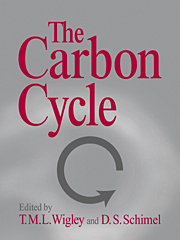Book contents
- Frontmatter
- Contents
- Preface
- Acknowledgments
- Contributors to the 1993 Global Change Institute
- I INTRODUCTION
- II THE MISSING CARBON SINK
- 3 Carbon Dioxide Emissions from Fossil Fuel Consumption and Cement Manufacture, 1751–1991, and an Estimate of Their Isotopic Composition and Latitudinal Distribution
- 4 Emissions of Carbon from Land-Use Change
- 5 The CO2 Fertilizing Effect: Relevance to the Global Carbon Cycle
- 6 Soils and the Global Carbon Cycle
- 7 Grasslands and the Global Carbon Cycle: Modeling the Effects of Climate Change
- 8 Constraints on the Atmospheric Carbon Budget from Spatial Distributions of CO2
- 9 Estimating Air–Sea Exchanges of CO2 from pCO2 Gradients: Assessment of Uncertainties
- 10 Atmospheric Oxygen Measurements and the Carbon Cycle
- 11 A Strategy for Estimating the Potential Soil Carbon Storage Due to CO2 Fertilization
- III PALEO-CO2 VARIATIONS
- IV MODELING CO2 CHANGES
- Part V Appendixes
- Index
11 - A Strategy for Estimating the Potential Soil Carbon Storage Due to CO2 Fertilization
from II - THE MISSING CARBON SINK
Published online by Cambridge University Press: 04 December 2009
- Frontmatter
- Contents
- Preface
- Acknowledgments
- Contributors to the 1993 Global Change Institute
- I INTRODUCTION
- II THE MISSING CARBON SINK
- 3 Carbon Dioxide Emissions from Fossil Fuel Consumption and Cement Manufacture, 1751–1991, and an Estimate of Their Isotopic Composition and Latitudinal Distribution
- 4 Emissions of Carbon from Land-Use Change
- 5 The CO2 Fertilizing Effect: Relevance to the Global Carbon Cycle
- 6 Soils and the Global Carbon Cycle
- 7 Grasslands and the Global Carbon Cycle: Modeling the Effects of Climate Change
- 8 Constraints on the Atmospheric Carbon Budget from Spatial Distributions of CO2
- 9 Estimating Air–Sea Exchanges of CO2 from pCO2 Gradients: Assessment of Uncertainties
- 10 Atmospheric Oxygen Measurements and the Carbon Cycle
- 11 A Strategy for Estimating the Potential Soil Carbon Storage Due to CO2 Fertilization
- III PALEO-CO2 VARIATIONS
- IV MODELING CO2 CHANGES
- Part V Appendixes
- Index
Summary
Abstract
Soil radiocarbon measurements can be used to estimate soil carbon turnover rates and inventories. A labile component of soil carbon has the potential to respond to perturbations such as CO2 fertilization, changing climate, and changing land use. Soil carbon has influenced past and present atmospheric CO2 levels and will influence future levels. A model is used to calculate the amount of additional carbon stored in soil because of CO2 fertilization.
Introduction
The Intergovernmental Panel on Climate Change estimates that doubling atmospheric CO2 over preindustrial levels will lead to a global-mean temperature increase of 1.5–4.5°C (e.g., Mitchell et al., 1990). Predicting when or if this doubling will occur requires an improved understanding of the global carbon cycle. One key question is the role of soil humus, which contains approximately 3 times the amount of carbon present in the preindustrial atmosphere. Scientists need to know if the soil carbon is labile or inert. If labile, soil carbon can respond to perturbations, either adding or removing atmospheric CO2. If inert, soil humus does not significantly influence atmospheric CO2 levels.
The purpose of this chapter is to show how soil radiocarbon measurements can be used to estimate soil carbon turnover times. The results presented here can be thought of as providing an example of what could be done on a biome-to-biome basis were more soil radiocarbon data available. Background material discusses the greenhouse effect, the global carbon cycle, and CO2 fertilization, which are linked with soil carbon turnover times.
- Type
- Chapter
- Information
- The Carbon Cycle , pp. 141 - 150Publisher: Cambridge University PressPrint publication year: 2000
- 1
- Cited by



